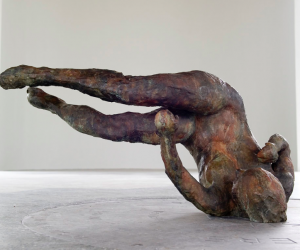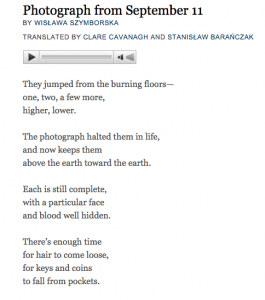Recently in ASTU we have been continuing our studies about how trauma is communicated. Specifically, this week we have been looking at how trauma can communicated through poetry. In class, we discussed the many poems that began to circulate after mass traumatic events such as 9/11. Through these discussions, I have been thinking a lot about the power of poetry in the communication of trauma as opposed to communicating through prose or visual art. Why can poetry seem to be less controversial than visual art or prose, when they are more-or-less communicating the same thing?
A prime example of this can be seen with the public’s negative and controversial reactions to Eric Fischl’s sculpture, “The Tumbling Woman” and the photograph of the “Falling Man,” but their contentment with Wislawa Szymborska’s poem, “Photograph from September 11.”


As you may notice, each of these items communicate trauma, and tell almost the identical story. However, the visual pieces became controversial, which lead to their removal from the public eye, whereas, this poem was, for the most part, happily received.
The public reaction to these images reminded me about an image that scarred the world just this last September. The picture I speak of is the photograph of Alan Kurdi, the little boy whose body was found washed upon a beach after his refugee family had attempted to flee Syria. This photograph gained so much controversy, however it sparked a conversation that no one wanted to talk about so much before.
I have been debating whether or not I want to post the picture we all know too well of Alan Kurdi on this blog post, and my gut is telling me to not. However, I do feel comfortable to share with you this poem written in memory of this little boy:
Poem by Ms. Zoe Gordon
A child lies dead
The
World is outraged
And
Yet
Tomorrow
A
boat
Will leave their shores
We
Will have more
Dead
And
Regrets
Stop
Wars
This Child
Represents
The world’s failure
To
Live in peace
The
World can see
We lack compassion
For our fellow man
When
We won’t help refugees
I believe that the fact that I do feel comfortable to share this poem about Alan Kurdi shows the immense power that poetry can have. Notice that this poem tells us the exact same thing that that photograph made us feel, but it is through the art form’s subtleties and less directness that allows us to join a conversation about such a difficult subject. The website I found this poem on, was filled with many other poems written, not by writers, but by just normal people, who used poetry to put a voice to their trauma, much the same as the flood of poetry that filled New York after the 9/11 attacks. Poetry gives us a language through which we can communicate our traumas. Through poetry we can communicate our trauma, not by showing, but by sharing.